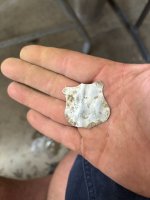Strictly from an academic perspective, I would like to share this interesting historical episode that happened in 1936, a find on the Magdalena River near the city of Honda here in Colombia. As one reads the newspapers and published contemporary reports of what is known as the “Mesuno hoard” some doubts and questions do arise. Very little has been studied with a scientific view of trying to understand what really happened and where those macuquinas came from.
Sedwick Coins summarizes it this way: "The name of this hoard comes from “El Mesuno,” the local name for a bend in the river where, in 1935, many hundreds of Bogotá cob 2 escudos were found in the riverbank. The latest of the coins, most of which did not show their peripheral dates, was 1636. No one knows how or why the hoard was lost; but it is known that Honda was where freshly struck coins from the Bogotá mint were offloaded from mules and put aboard riverboats to take the coins to Cartagena, on the Caribbean coast, where the coins were loaded onto galleons ultimately headed for Spain. Whether due to the sinking of a vessel or not, the “Mesuno Hoard” has been one of the world’s most important sources of gold cobs—basically the only source for Bogotá gold cobs of the early 1630s."
There are some minor errors here, the most recent coin is from 1642, the hoard was found in 1936 and there is no bend in the river where the coins were found though there is a sort of “rapids” there. Actually the Mesuno is an island in the river. The published accounts tell the storybook tale of three brothers who were fishermen and one “saw the glitter of the gold coins while fishing”, found an iron coffer and the coins, a gold chain and a few other golden artifacts. The three brothers later spent all the 2,000 coins in “ladies of the night” and getting drunk. All the coins were two escudos from 1629 to 1642. This is a local newspaper file:
http://www.epm.net.co/~ihenao/Pdf/El Mesuno R.pdf
The first question that came to my mind, having traveled the Magdalena River many times, is that its waters are very turbulent, receiving the rain flow of the upper Andes, carrying much sediment and debris. I have pictures of my father in that river in the same time period of 1936 and it was equally turbulent. How deep can one see a coin in that river? Maybe ten inches I would suspect. So did the coins come from a capsized “champan” (as the river going vessels of the time were called) or did the river erode one of the banks and the iron coffer fell into the shore and eventually broke up. If the coins were in fact in a vessel one would think they would not end up in the shallow shore part of the river and with time they would be ever deeper, covered by the sediment. Would an iron box withstand 300 years in a river and not corrode itself completely? The “Casa de la Moneda” museum, where the majority of the coins are housed, has not been able to document a wreck on the Magdalena that coincides with those years, 1642, 1643 or so.
These are some of the questions and the facts of the Mesuno Island hoard.
Panfilo
Sedwick Coins summarizes it this way: "The name of this hoard comes from “El Mesuno,” the local name for a bend in the river where, in 1935, many hundreds of Bogotá cob 2 escudos were found in the riverbank. The latest of the coins, most of which did not show their peripheral dates, was 1636. No one knows how or why the hoard was lost; but it is known that Honda was where freshly struck coins from the Bogotá mint were offloaded from mules and put aboard riverboats to take the coins to Cartagena, on the Caribbean coast, where the coins were loaded onto galleons ultimately headed for Spain. Whether due to the sinking of a vessel or not, the “Mesuno Hoard” has been one of the world’s most important sources of gold cobs—basically the only source for Bogotá gold cobs of the early 1630s."
There are some minor errors here, the most recent coin is from 1642, the hoard was found in 1936 and there is no bend in the river where the coins were found though there is a sort of “rapids” there. Actually the Mesuno is an island in the river. The published accounts tell the storybook tale of three brothers who were fishermen and one “saw the glitter of the gold coins while fishing”, found an iron coffer and the coins, a gold chain and a few other golden artifacts. The three brothers later spent all the 2,000 coins in “ladies of the night” and getting drunk. All the coins were two escudos from 1629 to 1642. This is a local newspaper file:
http://www.epm.net.co/~ihenao/Pdf/El Mesuno R.pdf
The first question that came to my mind, having traveled the Magdalena River many times, is that its waters are very turbulent, receiving the rain flow of the upper Andes, carrying much sediment and debris. I have pictures of my father in that river in the same time period of 1936 and it was equally turbulent. How deep can one see a coin in that river? Maybe ten inches I would suspect. So did the coins come from a capsized “champan” (as the river going vessels of the time were called) or did the river erode one of the banks and the iron coffer fell into the shore and eventually broke up. If the coins were in fact in a vessel one would think they would not end up in the shallow shore part of the river and with time they would be ever deeper, covered by the sediment. Would an iron box withstand 300 years in a river and not corrode itself completely? The “Casa de la Moneda” museum, where the majority of the coins are housed, has not been able to document a wreck on the Magdalena that coincides with those years, 1642, 1643 or so.
These are some of the questions and the facts of the Mesuno Island hoard.
Panfilo




